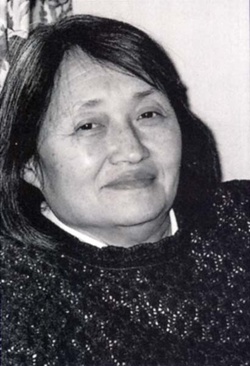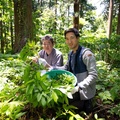Suki Setsuko Terada Ports is an outspoken woman with an infectious laugh and a straightforward manner. She is well known in New York as a dedicated and tireless activist. Ports has devoted much of her life to community service. In recent years most of her time has been spent helping to create AIDS projects, including one serving New York City’s Asian and Pacific Islander communities.
Suki calls her childhood “unusual.” Her father, Yoshio Albert Terada, grew up in Hawai‘i, where his parents worked on a sugar cane plantation on Maui and then moved to Honolulu. “He was like the first kid on his block to leave Hawai‘i and go to college in Oregon. After college he decided to go to business school in New York. He crossed the ocean from Hawai‘i to Oregon then to New York and Columbia Business School.”
Suki’s mother’s family immigrated from Japan to Washington when Sumiko Takai was just an infant. They settled on Vashon Island outside of Seattle. After high school she went to the University of Washington. At that time careers were limited for women and Suki’s mother decided to teach music. She was interested in classical music, so she came across the country to go to Teacher’s College and Juilliard School of Music “and of course these two odd fish out of water met, introduced by Professor Barry Tsunoda. So that’s how I grew up in the Columbia area and I still live there…it’s like a little village,” she says.
Ports’ father worked as a clerk for a small gift store called Aoyagi Company. The shop was in Times Square, on the ninth floor. “They sold Kodak cameras, watches, and golf equipment…American products that Japanese people wanted to take back to Japan.”
On Pearl Harbor day, Ports recalls that her older sister Ailyn had a good friend whose father worked for the New York Daily News. “He called my mother on Sunday morning and he said ‘tell your husband to come home right away,’ and she said ‘why?’ The store stayed open all day on Sundays…typical Japanese store…and he said ‘just tell him to come home right away.’ He told my mother that Pearl Harbor had just been bombed and he wasn’t sure if my father would be safe…my mother called my father to hurry up and tell Mr. Aoyagi what had happened. They closed shop and came home.”
Aoyagi was sent to Japan. Suki’s father, “having been born in Hawai‘i…and served on the ROTC in college, he was allowed to stay. He sort of inherited this customerless business overnight.” Keeping the business going would have been more of a struggle for the young Terada, except for the help of the First National City Bank of New York, now “Citibank.”
Terada was good friends with “one of the salesmen, a big husky Irish guy from Eastman Kodak,” Port remembers. He was in the store when another salesman came in and demanded his merchandise back. “I don’t deal with Japs,” the salesman said. “Daddy wrapped up his stuff and he left.” The Eastman Kodak salesman, Tom, said ‘Why didn’t you tell him off? You’re not a Jap, you’re an American!’ He got very incensed…and he said ‘Well don’t you worry Al, you’ll always have film.’
“Film became a very precious commodity during World War II and ironically some of the salesmen came back and begged my father for some of the film that he had that they couldn’t get hold of…and to my father’s credit he sold it to them. When Polaroid came out, and it was a very big novelty, he would never carry it, and when people asked him ‘why don’t you get modern?’ he would say ‘Nope, I don’t carry anything but Eastman Kodak.’
“Even though they didn’t get put into camps, my parents went through some of the same prejudice that people felt on the West Coast. It had a different effect on my mother because she was born in Japan. She was an alien and was placed under house arrest by the FBI for the duration of the war. The FBI asked the neighbors all sorts of questions about my family…did my parents have a lot of Japanese people going in and out and did the men have on uniforms, did they have long raincoats, did my parents have a short-wave radio, did my parents pull the shades down at night and did they speak Japanese to my sister and me? So we grew up with glass shelves with plants in front of the windows…they never pulled the shades down, they never played the radio at night, and they never spoke Japanese to us from that day on. We were denied that part of our heritage. They never invited anybody Japanese to the house after that except for all the Hawai‘i and California cousins and their Japanese American friends who came to have ‘rice’ my mom cooked for them before they embarked to fight in Italy.”
One summer during the war Suki and her sister Ailyn went to a Quaker summer camp. She remembers Parents Visiting Day, when she and her sister “ran away into the woods and cried all day because our parents didn’t come…When my older children were about six and eight…and it was time to let them go to summer camp, I don’t know where it came from but I said to my mother (in an angry voice) ‘You’re going to have to fix your dinner on Sunday because we’re going to camp, we’re going to visit our children. We think it’s important to visit our children on visiting day…” I was so rude to my mother, and she started to cry…it was the only time I saw her cry except when her parents died and she said, ‘We would have come, but the FBI wouldn’t let me leave Manhattan.’ So I ran to the phone and I called Ailyn and I said, “They would have come! They loved us the way American parents do!
“After all those years, she told us about the FBI. We grew up thinking she was such a wimp, she would always call and ask ‘can I go to so and so?’ and we always thought it was my dad but it was the FBI she was talking to. She wasn’t allowed to go more than two miles from our house without checking with the FBI… My sister and I would never have known these war stories if I hadn’t been so rude to my mother which is something I still feel badly about.”
“Even though my mother wasn’t in camp, all of her family was in camp and my aunt sent her letters asking her to send all kinds of things. They used to make all sorts of things in camp…all the yarn they used in my aunt’s camp (Tule Lake) must have come from my mom. That was one of the regular calls she made to the FBI, to go down to the lower East Side to the yarn shops and she used to buy orders, like 15 balls of pink, and 3 balls of blue. And my auntie in camp didn’t get the picture that asking for things meant that my mother would really scrimp to buy this yarn and other things. My auntie never knew that it was not so easy here.
“My kids think we grew up in the dark ages. They can hardly believe that we grew up without television. I told them that in the early years of the war, especially, things were hard. Ice cream or a bag of freshly roasted peanuts from the Yamasaki’s Tea Store were a big treat. Sometimes, we had rice with one egg drizzled on top for everyone.”
Ports remembers the effect that World War II had on the New York Japanese American community. “The Japanese school was closed immediately. There were a few businesses that were allowed to stay. That’s the difference between here and the West Coast… There was a little bit of a community that was allowed to stay. It was pretty devastating when people like Dr. Iwamoto were all of a sudden picked up and sent to Ellis Island. Unlike the West Coast, the community here was scattered. It’s even more scattered now. In 1968…we did a study of where seniors were, and we found that Japanese Americans were living in 99 postal zones in the area. It was because a lot of people leaving camp were told, ‘don’t make another Little Tokyo…scatter.’ People really took that seriously, so there were people in many different communities. The only central institutions were the churches. There was no real community center. We were invisible as an American ethnic group of Japanese ancestry.”
Reflecting on her Japanese American identity, Ports recalls her only visit to Japan, where she was invited to speak at an international conference on AIDS. She realized that she neither spoke nor really looked like the Japanese. She believes that the Japanese “sort of think of me as weird. In the Japanese American community, I’m different. In the Japanese community I’m different. It’s odd, having to teach people about Asian culture in my AIDS prevention work to American people who don’t know about Asians or Asian Americans and to be an Asian American and have people of that same ethnic background not quite understand who you are, and why you are how you are. At times it’s kind of…” She searches for a word.
*This article was originally published in the Japanese American National Museum Quarterly, Summer 1998.
© 2014 Japanese American National Museum







